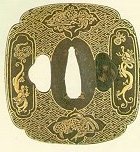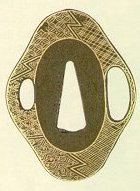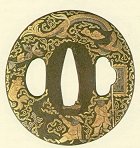Written by Sue Kent
SCNF
The Tsuba & Ishizuki
All conventional Japanese swords (katana & wakizashi) and many naginata are fitted with a tsuba. It is the largest of the sword fittings, and, in addition to being decorative, served to protect the Samurai's hands from injury. Naginata and katana blades were frequently used to block an attacker's strikes, and the tsuba helped to stop the attacker's blade from sliding down the length of the defender's blade and cutting his wrist or hand.
Prior to the 16th century, tsuba were usually made by blacksmiths and were composed of iron. Simple in design, they were used only for protection. Later, as metalworking technology improved, tsuba became much more ornate and were valued for their beauty as well as their functionality. By the 18th century, metals such as gold, silver, and the copper alloys of shakudo (3-7% gold), shibuichi (25% silver), sambo gin (33% silver), rogin (50% - 70% silver), karakane (a Chinese metal consisting of approximately 20% tin and lead), and sentoku (10% tin and zinc) were also used, primarily as decorative inlays in the tsuba. The application of various proprietary chemical compounds to these precious metals gave them a wide variety of colors.
Tsuba come in a variety of shapes and sizes, although most are round or oval in shape and have a diameter of approximately 2.5 to 3.5 inches.
The Tsuba & Ishizuki
All conventional Japanese swords (katana & wakizashi) and many naginata are fitted with a tsuba. It is the largest of the sword fittings, and, in addition to being decorative, served to protect the Samurai's hands from injury. Naginata and katana blades were frequently used to block an attacker's strikes, and the tsuba helped to stop the attacker's blade from sliding down the length of the defender's blade and cutting his wrist or hand.
Prior to the 16th century, tsuba were usually made by blacksmiths and were composed of iron. Simple in design, they were used only for protection. Later, as metalworking technology improved, tsuba became much more ornate and were valued for their beauty as well as their functionality. By the 18th century, metals such as gold, silver, and the copper alloys of shakudo (3-7% gold), shibuichi (25% silver), sambo gin (33% silver), rogin (50% - 70% silver), karakane (a Chinese metal consisting of approximately 20% tin and lead), and sentoku (10% tin and zinc) were also used, primarily as decorative inlays in the tsuba. The application of various proprietary chemical compounds to these precious metals gave them a wide variety of colors.
Tsuba come in a variety of shapes and sizes, although most are round or oval in shape and have a diameter of approximately 2.5 to 3.5 inches.
Assorted Tsuba


The Ishizuki
The ishizuki was mounted on the butt end of both the naginata and the yari (spear). It served not only to counterbalance the blade and protect the shaft, but was used to strike the enemy. It was particularly effective at penetrating between the plates of armor. Shown below are several commonly used styles of ishizuki:
Styles of Ishizuki


Naginata Construction
The Blade: Part 1
The Blade: Part 2
Crafting the Saya
The Saya